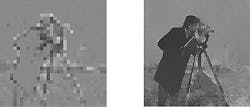System recovers quality images after compression
The discrete cosine transform (DCT) is one of the most widely used transforms in signal and image processing, especially in image and video compression applications.
In the JPEG image compression algorithm, for example, an input image is divided into 8 x 8 or 16 x 16 blocks, and a two-dimensional DCT computed for each block. The DCT coefficients are then quantized, coded, and transmitted. A JPEG receiver decodes the quantized DCT coefficients, computes the inverse two-dimensional DCT of each block, and then puts the blocks back together into a single image.
However, the DCT has the property that, for a typical image, most of the visually significant information about the image is concentrated in just a few coefficients of the DCT. If these coefficients are missing, it can lead to image degradation.
Now Shujun Li from the Department of Computing at the University of Surrey (Surrey, UK) has developed a system that can recover the missing coefficients in DCT-transformed images from the information contained in those that are known.
In his blog, Li says that even if the 15 most significant DCT coefficients are missing from each 8 × 8 block, some images can still be recovered with an acceptable quality.
Li presented his work at this year’s International Conference on Image Processing (ICIP 2011) in Brussels, Belgium. He believes that it has the potential to find applications in several sub-fields of multimedia coding including image compression, multimedia security, and forensics.
More information is available on Li’s blog.
-- By Dave Wilson, Senior Editor, Vision Systems Design
